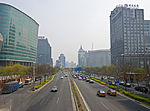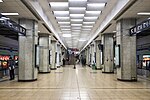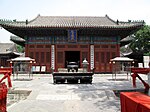Galaxy SOHO

Galaxy SOHO (simplified Chinese: 银河SOHO; traditional Chinese: 銀河SOHO; pinyin: Yínhé SOHO) is an urban complex building located in Beijing, China. Built between 2009 and 2012, it is the first of three buildings designed by Iraqi-British architect Zaha Hadid located in Beijing, along with Wangjing SOHO and Leeza SOHO. The building is located in the southwest corner of Chaoyangmen Bridge in the Second Ring Road of Beijing. The complex features a curvilinear design consisting of four asymmetric continuous structures. It covers an area of 330,000 m2. The parametric design of the building was inspired by classical Chinese courtyards. The complex offers shops, offices and entertainment facilities.
Excerpt from the Wikipedia article Galaxy SOHO (License: CC BY-SA 3.0, Authors, Images).Galaxy SOHO
S. Chaowai Str, Chaoyang District Chaowai (朝外街道)
Geographical coordinates (GPS) Address Phone number Nearby Places Show on map
Geographical coordinates (GPS)
| Latitude | Longitude |
|---|---|
| N 39.920827 ° | E 116.432883 ° |
Address
北京朝阳悠唐皇冠假日酒店
S. Chaowai Str 3
100020 Chaoyang District, Chaowai (朝外街道)
Beijing, China
Open on Google Maps









